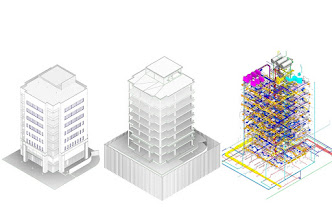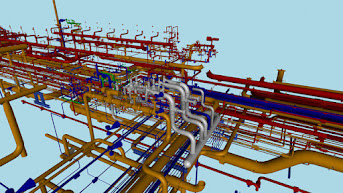The Benefits of 3D Rebar Modeling in Rebar CAD Services | Silicon Valley Infomedia Pvt. Ltd.
Hello to blog readers and CAD Designers,
Silicon Valley, noted for its tech creations, we Develop CAD drawings and designs for Architectural and Structural projects. It's also conducting the way in changing how we assemble things using state-of-the-art technology like 3D Rebar Modeling. In this blog, we'll explore how this technology is revolutionizing construction and pushing it more pleasing and various.
3D Rebar Modeling is an important part of making strong concrete buildings. It means drawing metal bars in a very detailed way to make sure the building can handle heavy stuff and pressure. In the past, people used 2D computer programs to do this, which took a lot of time, had mistakes, and wasn't very efficient. But now, with 3D rebar modeling, it's much better. It's more accurate, saves money, and gets the job done faster.
What is the 3D Rebar Modeling?
3D Rebar Modeling is a modern building technique that involves using specialized computer software to create a detailed, three-dimensional plan of the metal bars, known as reinforcement or rebars, that are used to make substantial structures stronger and more resilient.
Imagine you're creating a house with factual walls and floors. To ensure these structures can withstand the weight and forces they'll encounter over time, you need to add metal bars inside the concrete. These metal bars are like the "structure" that gives strength to the concrete. However, it's crucial that these bars are placed correctly and in the right position within the concrete to do their job effectively.
That's where 3D Rebar Modeling comes in. Instead of drawing these metal bars on paper, which can be time-consuming and prone to errors, engineers and architects use specialized computer software to create a precise 3D model of the rebar layout within the installation. This digital model shows exactly where each rebar should go, how long it should be, and its specific frontage.
In simple terms, 3D Rebar Modeling is like having a digital blueprint for the metal bars in a construction project. It ensures everything fits together correctly, making construction more efficient and accurate, ultimately leading to safer and stronger buildings.
Rebar Shop Drawings firms have emerged as a valuable resource for structure companies looking to streamline their rebar detailing processes. These firms employ skilled professionals who specialize in rebar detailing and use the latest software tools to create accurate, detailed, and error-free rebar shop drawings. By outsourcing rebar detailing services to a dedicated rebar shop drawing outsourcing firm, Modeling companies can save time, reduce costs, and ensure a higher level of accuracy in their rebar detailing.
Rebar CAD services are like using intelligent computer tools to make a 3D plan of metal bars for assembling things. They use fancy software like Tekla, AutoCAD, and Revit to complete really detailed and error-free 3D plans. These plans are so precise that they help 3D modeling companies build strong and accurate concrete structures.
One big advantage of using 3D rebar modeling in rebar CAD services is that it makes everything true to life. The software lets them create detailed and excellent Projects, so the structures can handle heavy stuff and anxiety. Also, it helps them spot issues where the metal bars might get in the way of other things in the structure, which stops expensive mistakes when building in 3D.
3D rebar modeling, which is like making a digital picture of the metal bars used in buildings, has advantages over the old way of drawing them in 2D on paper. It's done using special computer programs, and here are some good things about it.
The Benefits of 3D Rebar Modeling:
Sweetened Observation:
3D rebar models provide a more accurate and realistic representation of the reinforcement layout within a structure. This helps stakeholders, including architects, engineers, and contractors, to better understand the design intent and identify potential clashes or conflicts early in the project.
Clash Detection and Coordination:
3D rebar models can be integrated with other building information modeling (BIM) elements such as architectural and structural models. This integration allows for clash detection, ensuring that rebars do not interfere with other building components like HVAC ducts, plumbing, or electrical systems.
Mistake Deduction:
By working in a 3D environment, potential errors and conflicts can be identified and resolved before construction begins. This minimizes the likelihood of costly rework, delays, and design-related issues during construction.
Improved Structural Morality:
3D rebar modeling enables engineers to optimize the placement and orientation of reinforcement elements to improve the structural integrity of a building or infrastructure project. This can lead to more robust and cost-effective designs.
Amount and Price Analysis:
Accurate 3D models facilitate precise quantity take-offs and cost estimation for materials and labor, helping project managers and owners to budget more effectively.
Aerodynamic Transmission:
3D models provide a clear and standardized way to communicate design and construction requirements among project stakeholders, reducing misinterpretations and misunderstandings.
Efficient Fabrication and Installation:
Fibbers and building crews benefit from 3D rebar models because they can generate fabrication drawings directly from the model. This streamlines the manufacturing process and ensures that rebar is cut and bent accurately, saving time and reducing waste.
Recordkeeping and Informing:
3D rebar models can automatically generate detailed documentation, including bar bending schedules and shop drawings, reducing the need for manual drafting and increasing the accuracy of these documents.
Supervision and Adapting:
After construction, having an accurate 3D rebar model can be invaluable for maintenance and potential future retrofitting or renovation projects. It helps in locating and understanding the existing reinforcement layout.
Durability:
Optimizing reinforcement layouts and reducing material waste through 3D modeling can contribute to more sustainable construction practices by minimizing the environmental impact of construction projects.



Comments
Post a Comment